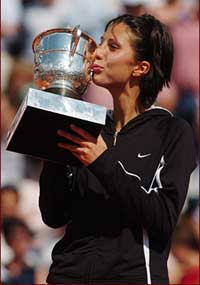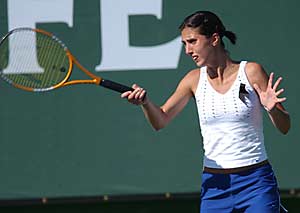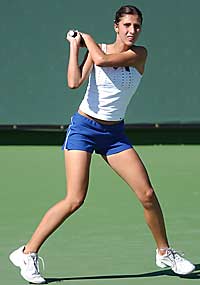TennisOne Lessons
![]()
Anastasia Myskina – “Brilliant Court Steward”
by Jim McLennan
 After her French Open win, Anastasia Myskina is now ranked third in the world |
The new French Open champion, who breezed through her final three matches, is now ranked third in the world. Big serve? Not necessarily. Huge forehand? Not really. Outstanding movement? Quick perhaps but again not really. What is going on here? I have read a number of articles about her and found references to her “steely nerves” and “brilliant court stewardship.” But what can we make of this?
In the quarterfinals she outplayed Venus Williams, 6-3, 6-4. She made 13 unforced errors to Venus's 43, and stroked 9 winners to Venus' 12. Winning margin - 27 points.
In the semifinals she outplayed Jennifer Capriati 6-2, 6-2. The unforced error ration was 29 for Anastasia to 36 for Capriati (this was reasonably close) but in winners it was 17 to 11. Winning margin - 13 points. And perhaps for this narrow margin to be reflected in a 6-2 6-2 drubbing, this margin must have occurred on the so called “big points.”
And in the finals she overwhelmed a nervous Elena Dementieva 6-1, 6-2, making 17 unforced errors to Elena's 33, and hitting 12 winners to Elena's 11. Winning margin -17 points.
So if Myskina's opponents committed 112 unforced errors in her last three matches – what exactly is meant by “steely nerves” and “brilliant court stewardship.” The steely nerves concept may be the easier one to define – ability to play loose under pressure, high percentage of first serves in order to avoid either second serves and or the potential for double faults. Composure to go for her shots when the opportunity presents itself. But really, Williams, Capriati and Dementieva all have solid clay court credentials, is Myskina just a “pusher” (and note I hate that word when used to derogate an opponent of any caliber) with good nerves, or is there something more to it?
 Huge forehand? Not really |
From where I sit, I think the issue is her court stewardship. Myskina thoroughly understands how to open the court when moving forward, play solid if unremarkable crosscourt tennis when holding her position, but importantly, play brilliant defense when moved back or pulled out of position.
Defense is as much about time as it is about angle. When Myskina is pulled wide and her court opens, this is the moment when her brilliant defense elicited the barrage of unforced errors.
The Art of Recovery
After contacting the ball players are advised to recover to the midline of the opponent's subsequent angle of play. Further the recovery steps culminate in a ready hop on this midline at the precise moment the opponent contacts the ball. Finally, when playing from the baseline, crosscourt drives reduce subsequent recovery steps, down the line drives increase the subsequent amount of recovery steps. Myskina performs this simple (yet somehow complicated) task perfectly.
 Is Myskina a master at the art of recovery? |
When Serena, Venus, Jennifer, or any of the big hitters are pulled out of position, often their reply reaches the opponent slightly before they have completed their recovery footwork. They can remain in the rally, but are often scrambling for the next few balls. This over hitting, robs them of recovery time, and reduces the difficulty the opponent has in deciding what to do (for the court is obviously open) and how to do it.
On the other hand, when Anastasia recovers perfectly on a shot that Venus, or Jennifer, or Elena presumed would open the court, at this moment they (Venus, Jennifer or Elena) must decide whether to restart the rally and create another opening, or whether they should go for the open court. There is truly a moment's hesitation here. Further, if they decide to go for the open court or even for the winner, they are likely to try and play it ever so closer to the line (for now they need to). Finally, if they drive the ball down the line to the open court but do not force Myskina, then her crosscourt reply has them out of position yet again.
Combine indecision, playing the ball closer to the line, and playing the ball down the line and subsequent poor recovery positioning – and I think you get 112 unforced errors committed against an excellent court steward.
Your comments are welcome. Let us know what you think about Jim McLennan's article by emailing us here at TennisOne.
![]()
|
Click here to order. |
The Secrets of World Class Footwork - Featuring Stefan Edberg by Jim McLennan Learn the secret to the quickest start to the ball, and the secret to effortless movement about the court. Includes footage of Stefan Edberg, one of the quickest and most graceful of all the professionals. |
Click here to order. |
|
Learn pattern movements to the volleys, groundstrokes, and split step reactions. Rehearse explosive starts, gliding movements, and build your aerobic endurance. If you are serious about improving your tennis, footwork is the key.
Includes video tape and training manual (pictured above). - $29.95 |
||